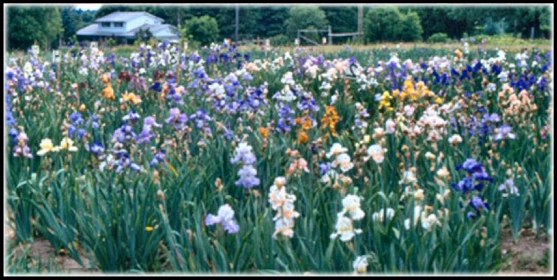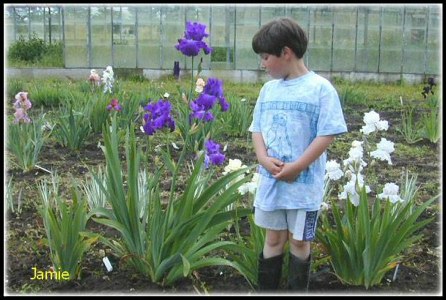Chapman Iris | home
Greetings | About Us | Upcoming Seedlings | Miniature Dwarf Bearded | Standard Dwarf Bearded | Intermediate Bearded | Miniature Tall Bearded | Border Bearded | Tall Bearded | Aril Bred | Beardless - Pseudacorus | Bearded - Species | Siberian | Spuria | Iris Notes | Planting Instructions | Iris Diseases | Hybridizing | Iris Terminology | Iris Awards | Special Events | Ordering Information
_______________________________________________
Planting Instructions
Care and Cultivation:
The plants are best moved in late July and through the month of August. This is the reason the plants are shipped when they are. Actually, they will move at other times with extra care - such as moving the dirt and taking full clumps or mother rhizome as well. For
 proper division and healthy spacing, late summer is the best. At this time the new rhizomes have reached proper maturity to be moved and they survive the shipping procedure very well. This time also gives the plant time to put down new roots before the onset of winter, which helps with winter survival. The plants are shipped freshly dug and should arrive after only a few days in transit. Note the healthy green colour of the foliage and the plumpness of the rhizome. Plants that are grown in another country and then shipped to the distributor are usually dried out, somewhat shriveled and often arrive fairly late to you garden, with decreased survival rate.
proper division and healthy spacing, late summer is the best. At this time the new rhizomes have reached proper maturity to be moved and they survive the shipping procedure very well. This time also gives the plant time to put down new roots before the onset of winter, which helps with winter survival. The plants are shipped freshly dug and should arrive after only a few days in transit. Note the healthy green colour of the foliage and the plumpness of the rhizome. Plants that are grown in another country and then shipped to the distributor are usually dried out, somewhat shriveled and often arrive fairly late to you garden, with decreased survival rate.Each variety has differences in the size of the rhizomes. What you receive are bloom size plants. With good care you should expect about 70% or better of the plants to bloom next spring. Best care involves planting the plants promptly in properly prepared soil. If the soil hasn't grown iris previously, then very little will be needed to prepare the soil. Some organic material can be added, but don't go too heavy with the compost as this can result in vigorous green growth and little bloom.
The plants should be spaced about 12-18" apart for Tall Bearded, and about 8-10" apart for the Dwarf Bearded. If you are planting in  clumps it is recommended to plant them in groups of three, in an equilateral triangle, with the growth points facing out (cut ends facing in) using the spacing's detailed above. It is a good idea to label the plants with a permanent marker of some sort. I use pieces cut from aluminum blinds, written on with a garden marker or paint marker. Dyno tape also offers some permanence, as does plastic labels printed on with a laser printer or copied onto plastic labels with a photocopier.
clumps it is recommended to plant them in groups of three, in an equilateral triangle, with the growth points facing out (cut ends facing in) using the spacing's detailed above. It is a good idea to label the plants with a permanent marker of some sort. I use pieces cut from aluminum blinds, written on with a garden marker or paint marker. Dyno tape also offers some permanence, as does plastic labels printed on with a laser printer or copied onto plastic labels with a photocopier.
 clumps it is recommended to plant them in groups of three, in an equilateral triangle, with the growth points facing out (cut ends facing in) using the spacing's detailed above. It is a good idea to label the plants with a permanent marker of some sort. I use pieces cut from aluminum blinds, written on with a garden marker or paint marker. Dyno tape also offers some permanence, as does plastic labels printed on with a laser printer or copied onto plastic labels with a photocopier.
clumps it is recommended to plant them in groups of three, in an equilateral triangle, with the growth points facing out (cut ends facing in) using the spacing's detailed above. It is a good idea to label the plants with a permanent marker of some sort. I use pieces cut from aluminum blinds, written on with a garden marker or paint marker. Dyno tape also offers some permanence, as does plastic labels printed on with a laser printer or copied onto plastic labels with a photocopier.The plants should have the top of the rhizome just at the surface of the soil, or barely covered in light soil. The roots should be as deep as possible. Winter protection is recommended for the first winter. A covering of about 6" of straw is very good. A covering of about 3" of soil will also work, as will the placing of a good sized rock (or brick) on top of the rhizome be also useful. Winter protection is less necessary in areas that get good, consistent snow cover. Protection is usually removed when the soil under the protection is thawed.
The plants need at least half a day of sun to perform well. They usually need dividing about every 4-5 years. Otherwise the new rhizomes will crown each other, preventing them from reaching blooming size. This is the commonest problem to the question: "Why are my Iris no longer blooming?". The solution is to divide and move the plants.
Forever Blue is an exceptionally strong grower and should be moved and divided every 2-3 years. The more often it is divided the more bloom you will get. Best rebloom seems to be the year after being divided.
Rebloomers:
The rhizomes of these plants are usually smaller when sent out as the larger rhizomes often have bloom stalks on them. If they send up a bloom stalk after being planted, it is recommended that you cut it off. Although it is tempting to see it bloom, this could result in the death of the plant, as energy needed for root growth and establishing itself is diverted to the flower.
Fertilizer:
Iris should be fertilized after the first year in new soil. The best times are early in the spring when they are starting to grow, and again just after they have finished blooming. The fertilizer should have about half the amount of nitrogen as the other ingredients. That is a 5-10-10 or 10-20-20 mix. A good organic fertilizer is alfalfa pellets. This is usually sold as horse food and is purchased in 25 kg bags. It is sprinkled lightly around the plant. The alfalfa works well for iris plants. For new beds mix in alfalfa pellets and compost.
